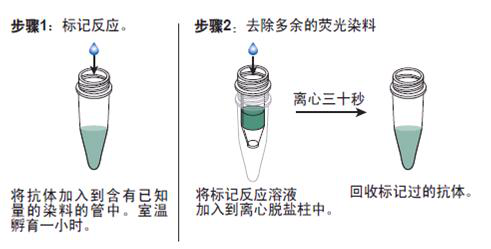
|

| 产地 | 进口、国产 |
| 品牌 | 上海莼试 |
| 保存条件 | Store at -20 °C |
| 货号 | CS9702 |
| 应用范围 | WB=1:100-500 ELISA=1:500-1000 IP=1:20-100 IHC-P=1:100-500 IHC-F=1:100-500 IF=1:100-500 |
| CAS编号 | |
| 抗体名 | Anti-NIRF |
| 克隆性 | |
| 靶点 | 详见说明书 |
| 适应物种 | 详见说明书 |
| 形态 | 详见说明书 |
| 宿主 | 详见说明书 |
| 亚型 | IgG |
| 标识物 | 详见说明书 |
| 浓度 | 1mg/1ml% |
| 免疫原 | KLH conjugated synthetic peptide derived from hu NIRF/RNF107 |
产品订购信息:
英文名称 Anti-NIRF
中文名称 环指蛋白107抗体规格
别 名 E3 ubiquitin-protein ligase UHRF2; Np95 like RING finger protein; Np95-like ring finger protein; Np95/ICBP90 like RING finger protein; Np95/ICBP90-like RING finger protein; Nuclear protein 97; Nuclear zinc finger protein Np97; RING finger protein 107; RNF 107; RP11-472F14.2; Ubiquitin like containing PHD and RING finger domains protein 2; Ubiquitin-like PHD and RING finger domain-containing protein 2; Ubiquitin-like-containing PHD and RING finger domains protein 2; Uhrf2; UHRF2_HUMAN.


浓 度 1mg/1ml
规 格 0.2ml/200μg
抗体来源 Rabbit
克隆类型 polyclonal
交叉反应 Human, Mouse, Rat, Dog, Cow
产品类型 一抗
研究领域 细胞生物 细胞周期蛋白 锌指蛋白
蛋白分子量 predicted molecular weight: 90kDa
性 状 Lyophilized or Liquid
免 疫 原 KLH conjugated synthetic peptide derived from hu NIRF/RNF107
亚 型 IgG
纯化方法 affinity purified by Protein A
储 存 液 Preservative: 15mM Sodium Azide, Constituents: 1% BSA, 0.01M PBS, pH 7.4
环指蛋白107抗体规格 产品应用 WB=1:100-500 ELISA=1:500-1000 IP=1:20-100 IHC-P=1:100-500 IHC-F=1:100-500 IF=1:100-500
(石蜡切片需做抗原修复)
not yet tested in other applications.
optimal dilutions/concentrations should be determined by the end user.
保存条件 Store at -20 °C for one year. Avoid repeated freeze/thaw cycles. The lyophilized antibody is stable at room temperature for at least one month and for greater than a year when kept at -20°C. When reconstituted in sterile pH 7.4 0.01M PBS or diluent of antibody the antibody is stable for at least two weeks at 2-4 °C.
Important Note This product as supplied is intended for research use only, not for use in human, therapeutic or diagnostic applications.
产品介绍 E3 ubiquitin-protein ligase which mediates ubiquitination and subsequent proteasomal degradation of PCNP. May participate in methylation-dependent transcriptional regulation. Important for G1/S transition. Overexpression causes G1 phase cell arrest.
Function : E3 ubiquitin-protein ligase that is an intermolecular hub protein in the cell cycle network. Through cooperative DNA and histone binding, may contribute to a tighter epigenetic control of gene expression in differentiated cells. Ubiquitinates cyclins, CCND1 and CCNE1, in an apparently phosphorylation-independent manner and induces G1 arrest. Also ubiquitinates PCNP leading to its degradation by the proteasome. E3 SUMO-, but not ubiquitin-, protein ligase for ZNF131.Subunit : Homodimer; disulfide-linked. Binds methylated CpG containing oligonucleotides. Interacts with H3: the interaction has a preference for the 'Lys-9' trimethylated form of H3 (H3K9me3) (By similarity). Interacts with PCNP, HDAC1 and CDK2 (inactive form). Component of a complex at least composed of UHRF2, CDK2 and CCNE1. Interacts directly with CCNE1; the interaction ubiquitinates CCNE1 and appears independent of CCNE1 phosphorylation. Interacts with CCND1; the interaction ubiquitinates CCND1 and appears independent of CCND1 phosphorylation. Interacts with p53/TP53 and RB1. Interacts with UBE2I.Subcellular Location : Nucleus. Note=Enriched at pericentric heterochromatin (PH). This localization is dependent on the interaction with H3K9me3 (By similarity).Post-translational modifications : May be autoubiquitinated; which may lead to proteasomal degradation.Phosphorylated. Phosphorylation may be mediated by CDK2.Autosumoylated.DISEASE : Note=Associated with various cancers. DNA copy number loss is found in multiple kinds of malignancies originating from the brain, breast, stomach, kidney, hematopoietic tissue and lung.Similarity : Contains 1 PHD-type zinc finger.Contains 1 RING-type zinc finger.Contains 1 ubiquitin-like domain.Contains 1 YDG domain.Database links : UniProtKB/Swiss-Prot: Q96PU4.1

A/H1N1-M2 Human(Avian influenza Matrix Protein-2 Human) A型人病毒H1N1-M2蛋白多肽Multi-class antibodies规格: 0.5mg
SERPINF2 SerpinF2 兔单抗 (PE) Human
Rhesus antibody Rh phospho-CREB-1(Ser129) 磷酸化CREB-1抗体 规格 0.1ml
淋巴细胞分离液(小鼠、大鼠、猪、兔等) 250ml
zbtb11 英文名称: 锌指蛋白913抗体 0.2ml
Dab1 英文名称: 磷脂蛋白受体Dab1抗体 0.1ml
SERPINF2 SerpinF2 兔单抗 (PE) Human
URGCP/URG4(Up-regulator of cell proliferation) 病毒X蛋白(HBxAg)抗原Multi-class antibodies规格: 0.5mg
Anti-Beta-Actin β-肌动蛋白抗体(内参抗体)Multi-class antibodies规格: 0.1ml
Rhesus antibody Rh phospho-c-Raf(Ser259) 磷酸化原癌基因c-Raf抗体 规格 0.1ml
兔抗大鼠IgG纯化抗体 1mg/10mg 国产
YAP1 英文名称: 原癌基因Yes相关蛋白1抗体 0.2ml
DPYD 英文名称: 二氢嘧啶脱氢酶抗体 0.2ml
Anti-Beta-Actin β-肌动蛋白抗体(内参抗体)Multi-class antibodies规格: 0.1ml
SHARPIN 英文名称: 线性泛素链相关蛋白SHARPIN抗体 0.2ml
Epsin 1 英文名称: 内吞作用辅助蛋白EPN1抗体 0.2ml
细胞周期调控因子34 Anti-Cdc34 0.1ml
Anti-Visfatin-2(CT)/FITC 荧光素标记内脂素/内脏脂肪素(C端抗体)IgGMulti-class antibodies规格: 0.2ml
Rhesus antibody Rh phospho-GAB2 (Tyr643) 磷酸化接头蛋白Gab2抗体 规格 0.1ml
CK14/17/42/10 peptide 细胞角蛋白14抗原Multi-class antibodies规格: 0.5mg
H2STestMediumAgar
FWA淡水鱼类琼脂培养基 250g 用于淡水鱼类肠道内细菌检测
李氏菌选择性培养基基础(MMA) Modified Mcbride Agar Base 250 用于单增李氏菌选择性分离(SN标准)
胰酪胨大豆肉汤250g/瓶用于金黄色葡萄球菌的增菌和MPN试验incubationmedia胰酪胨大豆肉汤250g/瓶用于金黄色葡萄球菌的增菌和MPN试验
即用型管装培养基
TrypticaseSoy-YeastExtractBroth
酪蛋白琼脂 Casein Agar 用于蜡样芽孢杆菌的酪蛋白分解试验
卵黄甘露醇高盐琼脂基础 Egg-Yolk Mannitol Salt Agar Base 250克 金黄色葡萄球菌的分离培养
2×YT培养基250g/瓶用于重组大肠杆菌菌株的培养incubationmedia2×YT培养基250g/瓶用于重组大肠杆菌菌株的培养
肠球菌、溶血性链球菌和粪链球菌检验培养基
环指蛋白107抗体规格 奈瑟氏菌属细菌生化鉴定盒 规格: 8种×10次/盒 用途: 用于奈瑟氏菌属细菌生化鉴定
霍乱弧菌生化鉴定盒 规格: 11种×10次 用途: 霍乱弧菌生化鉴定
弧菌科细菌生化鉴定盒(16种×5次) 规格: 16种×5次 用途: 弧菌的生化鉴定
麦氏比浊管 规格: 1套/盒 用途:

抗体的生物素化标记实验要点:
1. 环指蛋白107抗体规格 如在反应混合液中有叠氮钠或游离氨基存在,会抑制标记反应。因此,蛋白质在反应前要对 0.1mol/L碳酸氢钠缓冲液或0.5mol/L硼酸缓冲液充分透析;
2.所用的NHSB及待生物素化蛋白质之间的分子比按蛋白质表面的ε-氨基的密度会有所不同,选择不当则影响标记的效率,应先用几个不同的分子比来筛选最适条件;
3.用NHSB量过量也是不利的,抗原的结合位点可能因此被封闭,导致抗体失活;
4.由于抗体的氨基不易接近可能造成生物素化不足,此时可加入去污剂如 Triton x-100, Tween20等;
5.当游离ε-氨基(赖氨酸残基的氨基)存在于抗体的抗原结合位点时,或位于酶的催化位点时,生物素化会降低或损伤抗体蛋白的结合力或活性;
6.生物素还可能与不同的功能基团,如羰基、氨基、巯基、异咪唑基及*基,也可与糖基共价结合;
7.交联反应后,应充分透析,否则,残余的生物素会对生物素化抗体与亲和素的结合产生竞争作用;
8.在细胞的荧光标记实验中,中和亲和素的本底低,但由于链霉亲和素含有少量正电荷,故对某些细胞可导致高本底。
抗体的鉴定:
1)环指蛋白107抗体规格 抗体的效价鉴定:不管是用于诊断还是用于,制备抗体的目的都是要求较高效价。不同的抗原制备的抗体,要求的效价不一。鉴定效价的方法很多,包括有试管凝集反应,琼脂扩散试验,酶联免疫吸附试验等。常用的抗原所制备的抗体一般都有约成的鉴定效价的方法,以资比较。如制备抗抗体的效价,一般就采用琼脂扩散试验来鉴定。
2)抗体的特异性鉴定:抗体的特异性是指与相应抗原或近似抗原物质的识别能力。抗体的特异性高,它的识别能力就强。衡量特异性通常以交叉反应率来表示。交叉反应率可用竞争抑制试验测定。以不同浓度抗原和近似抗原分别做竞争抑制曲线,计算各自的结合率,求出各自在IC50时的浓度,并按公式计算交叉反应率。
如果所用抗原浓度IC50浓度为pg/管,而一些近似抗原物质的IC50浓度几乎是无穷大时,表示这一抗血清与其他抗原物质的交叉反应率近似为0,即该血清的特异性较好。
3)抗体亲和力:是指抗体和抗原结合的牢固程度。亲和力的高低是由抗原分子的大小,抗体分子的结合位点与抗原决定簇之间立体构型的合适度决定的。有助于维持抗原抗体复合物稳定的分子间力有氢键,疏水键,侧链相反电荷基因的库仑力,范德华力和空间斥力。亲和力常以亲和常数K表示,K的单位是L/mol。抗体亲和力的测定对抗体的筛选,确定抗体的用途,验证抗体的均一性等均有重要意义。